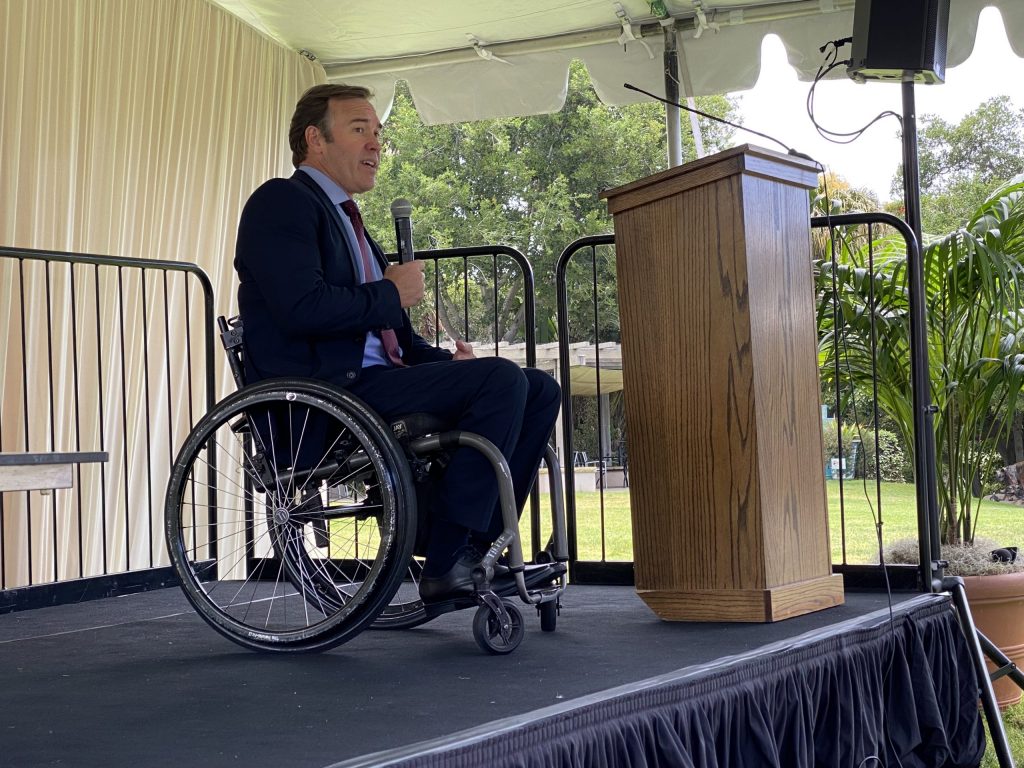Improving accessibility is key for South Coast tourism

According to Victoria Strong, founder and executive director of the Gwendolyn Strong Foundation, one in four Americans are disabled, with the number growing to one in two for those over the age of 65. This is a target market the tourism industry just isn’t reaching — but it is one it is trying to reach with a little more patience, effort and compassion.
At Visit Santa Barbara’s annual general meeting, hosted at the Santa Barbara Zoo on May 11, accessibility was a top concern for restaurateurs, hoteliers and other tourism professionals in attendance.
The event was held during National Travel and Tourism Week and celebrated the Santa Barbara South Coast tourism industry, one that generates more than $1.9 billion for the region as well as $56 million in yearly tax revenue and the creation of 13,000 jobs.
Kathy Janega-Dykes, president and CEO of Visit Santa Barbara, acknowledged that the event provided a great opportunity to reflect on the value of the local tourism industry and Visit Santa Barbara’s efforts in marketing the South Coast to visitors. The bureau worked around the clock to give the all-clear to the rest of the world that Santa Barbara was only briefly hindered by the severe winter storms.
“As we continue to welcome back visitors to the American Riviera, I’m proud of our leadership, the Visit Santa Barbara team and our hospitality community for demonstrating resilience and ingenuity,” said Janega-Dykes.
In addition to Strong speaking about her family’s experience and on behalf of her daughter’s foundation, John Sage, founder and CEO of Accessible Travel Solutions, also spoke on accessibility in the travel industry.
Other organizations represented include PathPoint, Autism Embrace, NatureTrack and Alpha Resource Center.
Strong shared her personal experience as a traveler, first as an independent adult and then with a differently abled child, and how her perspective shifted upon realizing what was possible and what could be made possible with more inclusive practices.
Her daughter was diagnosed with spinal muscular atrophy at around six months old and this put her and her partner’s love of traveling on pause.
“We recognized how very lucky we were to live in Santa Barbara. From our hometown, we could take her on walks pretty much year-round… These simple walks soon turned to family ventures downtown, visiting businesses, getting coffee together, having dates and connecting with our community at a time when we felt very isolated and alone,” said Strong.
Their bubble only expanded and soon they were traveling around the state and then about the country. Everywhere they went, they were pleasantly surprised by how accommodating most venues were open to being.
Despite the Americans with Disabilities Act being over thirty years old, Strong believes compliance with the law is the bare minimum, and should be exceeded in order to provide the most hospitable experience to travelers with different abilities.
She quoted a study that found 60% of travelers with disabilities who have stayed overnight in paid accommodations said they experienced problems including physical barriers, customer service or communication. She continued by quoting a second study that found 85% of adults with disabilities are not satisfied with the status of the ADA.
“I can affirm the ADA bar is incredibly low. Just in regards to public playgrounds, the ADA doesn’t even expect people with disabilities, children, to be able to use any of the equipment to actually play. The ADA only requires a path into the playground, so that is the bare minimum cities have provided for decades,” said Strong.
Sage echoed Strong’s sentiments but added that when he’s at home, he doesn’t recognize his disability as much because his surroundings have been built up around him to be accommodating.
“But when I start to travel, I start to run into unexpected accessibility barriers and I start to feel my disability and so that causes a lot of us with disabilities to choose not to travel,” said Sage.
The example he gave was that of the handheld, detachable showerhead. At home, he can leave it wherever he needs, but when staying in a hotel, housekeeping will put the handle back in its place every day, just shy of his reach, presenting an unnecessary obstacle.
He also discussed the three pillars of accessible travel, originally developed by the European Network of Accessible Tourism, which are facilities, customer service and information accessibility.
Sage touched on the idea of businesses being proactive rather than reactive to potentially disabled visitors’ needs. “It shouldn’t be my responsibility to make sure your places are accessible.”
The consensus was that Santa Barbara is on its way to becoming a more inclusive hometown and vacation destination every day.
email: [email protected]








